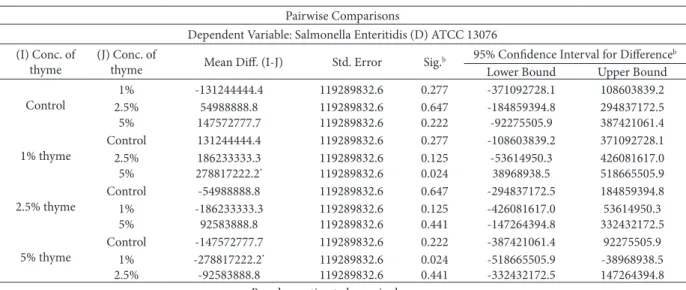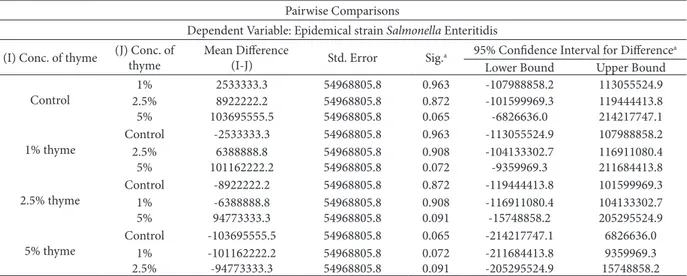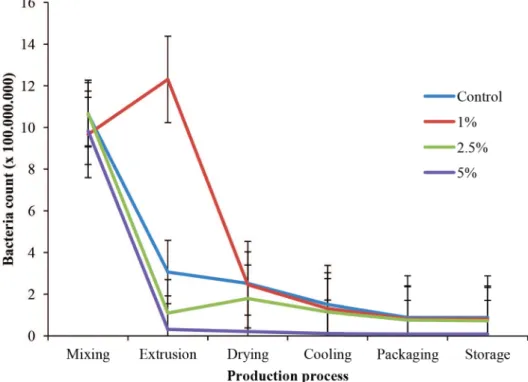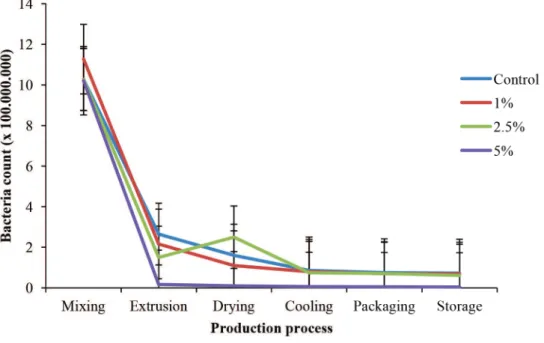213
ANTIMICROBIAL ACTIVITY OF SWEET BASIL AND THYME AGAINST SALMONELLAENTERICA SEROTYPE ENTERITIDIS IN EGG-BASED PASTA
Jasmina Stojiljković1, Miomir Nikšić2, Nikola Stanišić3, Zoran Stojiljković4 and Goran Trajkovski5
1College of Applied Studies, 17500 Vranje, Serbia
2 Institute for Food Technology and Biochemistry, University of Belgrade, Faculty of Agriculture, 11080 Belgrade, Serbia 3 Institute for Animal Husbundry, 11080 Belgrade-Zemun, Serbia
4 ECOVIVENDI d.o.o., 11 000 Belgrade, Serbia
5University of Cyril and Methodius, Faculty of Agricultural Science and Food, Skopje, Macedonia
Abstract - Salmonella enterica serotype Enteritidis is known as one of the most common pathogenic bacteria causing sal-monellosis in humans. Raw materials of animal origin (eggs, chicken meat) are frequent vectors that transmit this bacte-rium. Since eggs are used for the production of pasta, due to insuicient thermal treatment during pasta drying, they can be a potential risk to consumer health. Diferent essential oils of herbs can be used to reduce present pathogenic microor-ganisms. his paper compares a decrease in the number of Salmonella enterica serotype Enteritidis (D) ATCC 13076 and
Salmonella enterica serotype Enteritidis isolated from outbreaks of salmonellosis in egg-based pasta under the inluence of thyme and sweet basil essential oils. he results indicate that the utilized oils were more efective against the epidemic strain than the ATCC strain. In addition, thyme oil caused a more signiicant inhibition of Salmonella enterica serotype Enteritidisduring the production process.
Key words: egg-based pasta; Salmonella Enteritidis; sweet basil; thyme
Received November 18, 2014; Accepted November 28, 2014
INTRODUCTION
Salmonellosis is an infectious disease of humans and animals. Although primarily intestinal bacteria, salmonellae are widespread in the environment and may commonly be found in farm eluents, human sewage and in any material subject to fecal contam-ination. Salmonellosis has been recognized in all countries, but appears to be most prevalent in are-as of intensive animal husbandry, especially that of poultry or pigs (OIE, 2008).
Salmonellosis can afect all species of domestic animals; young animals and pregnant animals are
the most susceptible. Enteric disease, oten present-ing as a bloody or profuse watery diarrhea with py-rexia, is the commonest clinical manifestation, but a wide range of clinical signs, which include acute sep-ticemia, abortion, arthritis, necrosis of the extremi-ties and respiratory disease, may be seen. he signs and lesions are not pathognomonic. Many animals, especially poultry and pigs, may also be infected but show no clinical illness (Wray and Wray, 2000).
Salmonel-la species are intolerant to high concentrations of salt and nitrites, so they are usually not found in cured meat. On the other hand, thermally untreated eggs represent a very good substrate for the growth of Sal-monella spp. Eggs can be infected by Salmonella via two ways of transmission, vertical and horizontal. Vertical transmission occurs when the egg contents are contaminated with Salmonella during the forma-tion of the egg (Messens, 2005). he horizontal route includes trans-shell infection of the contents of eggs during their transit through the cloacae (EFSA, 2005; Martelli and Davies, 2012).
Inside the egg, the growth of Salmonella is fa-cilitated by the temperature of storage. Eggs should be stored at a constant temperature that should not exceed 20ºC (ACMSF, 1993; Martelli, 2012). Salmo-nella can grow at 20ºC in the egg albumen, while it is unable to grow at temperatures less than 10ºC. If
Salmonella reaches the egg yolk, it can grow rapid-ly, even at room temperature (25ºC) (Gantois et al., 2009; Martelli, 2012). Humans are most frequently intoxicated with salmonellae ater they have con-sumed raw and undercooked eggs (Martelli, 2012).
During the production of egg-based pasta, dry-ing is at 46ºC. Since Salmonella Enteritidis can sur-vive even higher temperatures (Blackburn et al., 1997) there is a potential risk of the contamination of the inal product. herefore, additional treatment can be performed in order to ensure the elimination of Salmonella enterica serotype Enteritidis in egg-based pasta.
Determination of the antimicrobial activity of 17 essential oils against Escherichia coli O157:H7 and
Salmonella enterica in apple juices indicated that the reduction in the number of bacteria can reach 50% (Friedman et al., 2004). In addition, signiicant inac-tivation of Salmonella Enteritidis in tomato juice was achieved by the previous addition of citric acid or cinnamon bark oil (Mosqueda-Melgar et al., 2008). he essential oil of cloves, cinnamon, bay and thyme were tested against Listeria monocytogenes and Sal-monella Enteritidis in sot cheese; clove oil was found to be more efective against Salmonella Enteritidis in
full fat cheese than in cheese slurry. Cinnamaldehyde and thymol were efective against six Salmonella se-rotypes on alfalfa seeds (Burt, 2004). Also, Salmonel-la Enteritidis in various foods can be reduced by use of the essential oils of lemongrass, cinnamon leaf, ge-raniol, thyme, oregano, clove bud, allspice, bay leaf, palmarosa and marjoram oils (Duan and Zhao, 2009; Raybaudi-Massilia et al., 2006; Friedman et al., 2002; Burt, 2004).
he aim of this research was to determine the an-timicrobial activity of the essential oils of sweet basil and thyme against Salmonella enterica serotype Ente-ritidis in egg-based pasta. In addition, the activity of the oils was investigated against both Salmonella enterica se-rotypeEnteritidis (D) ATCC 13076 and the epidemic strain of Salmonella enterica serotype Enteritidis.
MATERIALS AND METHODS
Egg-based pasta technology and the sampling procedure
Egg-based pasta was made by the following reci-pe: 10 kg wheat grits and 2 kg wheat lour, 24 eggs, 3.2-3.4 L water and 0.010 kg β-carotene. Ingredients were mixed and 25 g of the dough was inoculated with 0.1 mL of the suspension of the investigated species of bacteria with the initial number of bacteria 109 CFU/g. Ater inoculation, diferent amounts of sweet basil and thyme essential oil (Fitofarm, Skop-je, Republic of Macedonia) were added to the pre-pared dough, at inal concentrations of 1%, 2.5% and 5%. Pasta was formed by extrusion and then dried in a chamber at a temperature of 46ºC and relative humidity of 80% for 9 h. Aterwards the pasta was cooled at room temperature for 15 min and packed into PE bags. Samples of the pasta with and without the addition of oils were taken during the following production stages: dough making, dough extrusion, pasta drying, pasta cooling, pasta packaging.
Microorganisms
ATCC 13076 from the MicroBioLogics, Ins. Joins ATCC Proiciency Standard Program, Minnesota, USA, and Salmonella enterica serotype Enteritidis 6084 isolated from outbreaks of salmonellosis in the
National Institute of Public Health, Leskovac, Serbia.
Enumeration of bacteria
Determination of the number of Salmonellaenterica
serotype Enteritidis (D) ATCC 13076 and epidemic strain was performed according to the methods for microbiological analysis and super-analysis of food.
A quantity of 25 g of pasta was mixed with 225 mL of sele-nite broth (Torlak, Belgrade, Serbia) and incubated for 24 h at 37ºC. Inoculation was carried out by spreading 0.1 mL of the appropriate dilution on the surface of SS agar (Torlak, Belgrade, Serbia) plates. Enumeration of bacteria was performed ater incubation at 37 ºС during 24 h. All experiments were done in triplicate.
Statistical analysis
Data were subjected to analysis using MS Oice Ex-cel and the computer program SPSS 17. A two-fac-torial experiment was used to compare the signii-cance of diferences in means between the control and concentrations of 1%, 2.5% and 5% of sweet basil and thyme against Salmonellaenterica serotype En-teritidis (D) ATCC 13076 and the epidemical strain
Salmonellaenterica serotype Enteritidis in egg-based pasta.
RESULTS
In the EU, Salmonella Enteritidis and Salmonella
Typhimurium are the serovars most frequently as-sociated with human illness. Human Salmonella En-teritidis cases are most commonly associated with the consumption of contaminated eggs and poul-try meat, while Salmonella Typhimurium cases are mostly associated with the consumption of contam-inated pig, bovine and poultry meat (EFSA, 2013).
In order to investigate the possible efect of the essential oil of sweet basil and thyme on the reduc-tion of growth of Salmonella enterica serotype
Ente-ritidis in egg-based pasta the number of bacteria was determined during diferent stages of the production process. Pasta was inoculated with Salmonella en-terica serotype Enteritidis (D) ATCC 13076 and the epidemic strain with an initial number of bacteria of 109 CFU/g, and diferent concentrations of essential oils were added.
During the production process, the number of
Salmonella Enteritidis (D) ATCC 13076 in egg-based pasta with sweet basil decreased by 1 log CFU/g (Fig. 1). he addition of 1% and 2% of essential oil of sweet basil had no inluence on the number of Salmonel-la enterica serotype Enteritidis (D) ATCC 13076 in the pasta. he addition of 5% of essential oil of sweet basil reduced the number of S. Enteritidis (D) ATCC 13076 during extrusion by 0.14 log CFU/g. he greatest reduction was observed during cooling, 0.76 log CFU/g, while in the inal product it was 0.51 log CFU/g compared to the control. Comparison of the impact of diferent concentrations of sweet basil against Salmonella enterica serotype Enteritidis (D) ATCC 13076 is shown in Table 1.
he greatest decrease in the pasta ater the addi-tion of thyme essential oil at a concentraaddi-tion of 2.5% was observed during the extrusion phase, however, the inal number Salmonellaenterica serotype Ente-ritidis (D) ATCC 13076 was slightly lower as com-pared to the control (Fig. 2). On the other hand, the addition of 5% of thyme oil led to a reduction of up to 1.29 log units, which was observed during drying. his concentration of thyme oil caused the decrease in the number of ATCC strain by 1 log unit during the extrusion and this diference remained most-ly stable to the end of the anamost-lyzed process. Com-parison of the impact of diferent concentrations of thyme against Salmonella enterica serotype Enter-itidis (D) ATCC 13076 is shown in Table 2.
he results obtained during the investigation of the inluence of sweet basil on the epidemic strain
basil in the concentration of 5% caused a decrease in the number of epidemic Salmonella enterica during storing of the egg-based pasta by 1 log unit. his is in agreement with the investigation of Barbosa et al. (2009) who achieved a reduction of 1-1.3 log units of Salmonella Enteritidis with the addition of
essen-tial oils. he concentration of 5% of sweet basil oil was more efective in the case of the epidemic strain than the ATCC strain. Comparison of the impact of diferent concentrations of sweet basil against Salmo-nella enterica serotype Enteritidis epidemic strain is shown in Table 3.
Table 1. Comparison of impact of diferent concentrations of sweet basil on Salmonella enterica serotype Enteritidis (D) ATCC 13076.
Pairwise Comparisons
Dependent Variable: Salmonella Enteritidis (D) ATCC 13076 (I) Conc. of sweet
basil
(J) Conc. of sweet basil
Mean Diference
(I-J) Std. Error Sig.b
95% Conidence Interval for Diferenceb
Lower Bound Upper Bound Control 2.5% 1% 80777777.744111111.1* 35935036.935935036.9 0.2260.029 -28141123.28525543.4 116363345.4153030012.1
5% 144616666.6* 35935036.9 0.000 72364432.2 216868901.0
1% sweet basil Control2.5% -44111111.136666666.6 35935036.935935036.9 0.2260.313 -116363345.4-35585567.7 108918901.028141123.2
5% 100505555.5* 35935036.9 0.007 28253321.1 172757789.9
2.5% sweet basil
Control -80777777.7* 35935036.9 0.029 -153030012.1 -8525543.4
1% -36666666.6 35935036.9 0.313 -108918901.0 35585567.7
5% 63838888.8 35935036.9 0.082 -8413345.4 136091123.2
5% sweet basil Control -144616666.6
* 35935036.9 0.000 -216868901.0 -72364432.2
1% -100505555.5* 35935036.9 0.007 -172757789.9 -28253321.1
2.5% -63838888.8 35935036.9 0.082 -136091123.2 8413345.4
Based on estimated marginal means
*he mean diference is signiicant at the 0.05 level
b Adjustment for multiple comparisons: Least Signiicant Diference (equivalent to no adjustments)
Table 2. Comparison of impact of diferent concentrations of thyme on Salmonella enterica serotype Enteritidis (D) ATCC 13076
Pairwise Comparisons
Dependent Variable: Salmonella Enteritidis (D) ATCC 13076 (I) Conc. of
thyme
(J) Conc. of
thyme Mean Dif. (I-J) Std. Error Sig.b
95% Conidence Interval for Diferenceb
Lower Bound Upper Bound Control
1% -131244444.4 119289832.6 0.277 -371092728.1 108603839.2
2.5% 54988888.8 119289832.6 0.647 -184859394.8 294837172.5
5% 147572777.7 119289832.6 0.222 -92275505.9 387421061.4
1% thyme
Control 131244444.4 119289832.6 0.277 -108603839.2 371092728.1
2.5% 186233333.3 119289832.6 0.125 -53614950.3 426081617.0
5% 278817222.2* 119289832.6 0.024 38968938.5 518665505.9
2.5% thyme
Control -54988888.8 119289832.6 0.647 -294837172.5 184859394.8
1% -186233333.3 119289832.6 0.125 -426081617.0 53614950.3
5% 92583888.8 119289832.6 0.441 -147264394.8 332432172.5
5% thyme
Control -147572777.7 119289832.6 0.222 -387421061.4 92275505.9
1% -278817222.2* 119289832.6 0.024 -518665505.9 -38968938.5
2.5% -92583888.8 119289832.6 0.441 -332432172.5 147264394.8
Based on estimated marginal means * he mean diference is signiicant at the 0.05 level
As was observed for the sweet basil oil, the epi-demic strain is less resistant to the addition of thyme oil than the ATCC strain (Fig. 4). he addition of 2% of thyme oil had little inluence on the growth of the epidemic strain. he increase in the concentration of oil to 5% caused stronger inhibition and a reduc-tion in the number of epidemic strain from 8.42 to
7.23 log CFU/g during extrusion. he number of
Salmonella Enteritidis in the inal product was lower by 1.52 log units in the pasta with 5% of thyme oil compared to the control. Comparison of the impact of diferent concentrations of thyme against Salmo-nella enterica serotype Enteritidis epidemical strain is shown in Table 4.
Table 3. Comparison of impact of diferents concentrations of sweet basil on Salmonella enterica serotype Enteritidis epidemical strain
Pairwise Comparisons
Dependent Variable: Epidemical strain Salmonella Enteritidis (I) Conc. of sweet
basil
(J) Conc.of sweet basil
Mean Diference
(I-J) Std. Error Sig.a
95% Conidence Interval for Diferencea
Lower Bound Upper Bound Control
1% 24950000.0 106189918.3 0.815 -188559140.8 238459140.8
2.5% -16994444.4 106189918.3 0.874 -230503585.2 196514696.3
5% 115083333.3 106189918.3 0.284 -98425807.4 328592474.1
1% sweet basil
Control -24950000.0 106189918.3 0.815 -238459140.8 188559140.8
2.5% -41944444.4 106189918.3 0.695 -255453585.2 171564696.3
5% 90133333.3 106189918.3 0.400 -123375807.4 303642474.1
2.5% sweet basil
Control 16994444.4 106189918.3 0.874 -196514696.3 230503585.2
1% 41944444.4 106189918.3 0.695 -171564696.3 255453585.2
5% 132077777.7 106189918.3 0.220 -81431363.0 345586918.5
5% sweet basil
Control -115083333.3 106189918.3 0.284 -328592474.1 98425807.4
1% -90133333.3 106189918.3 0.400 -303642474.1 123375807.4
2.5% -132077777.7 106189918.3 0.220 -345586918.5 81431363.0
Based on estimated marginal means
a Adjustment for multiple comparisons: Least Signiicant Diference (equivalent to no adjustments)
Table 4. Comparison of impact of diferent concentrations of thyme on Salmonella enterica serotype Enteritidis epidemical strain
Pairwise Comparisons
Dependent Variable: Epidemical strain Salmonella Enteritidis (I) Conc. of thyme (J) Conc. of
thyme
Mean Diference
(I-J) Std. Error Sig.a
95% Conidence Interval for Diferencea
Lower Bound Upper Bound Control
1% 2533333.3 54968805.8 0.963 -107988858.2 113055524.9
2.5% 8922222.2 54968805.8 0.872 -101599969.3 119444413.8
5% 103695555.5 54968805.8 0.065 -6826636.0 214217747.1
1% thyme
Control -2533333.3 54968805.8 0.963 -113055524.9 107988858.2
2.5% 6388888.8 54968805.8 0.908 -104133302.7 116911080.4
5% 101162222.2 54968805.8 0.072 -9359969.3 211684413.8
2.5% thyme
Control -8922222.2 54968805.8 0.872 -119444413.8 101599969.3
1% -6388888.8 54968805.8 0.908 -116911080.4 104133302.7
5% 94773333.3 54968805.8 0.091 -15748858.2 205295524.9
5% thyme
Control -103695555.5 54968805.8 0.065 -214217747.1 6826636.0
1% -101162222.2 54968805.8 0.072 -211684413.8 9359969.3
2.5% -94773333.3 54968805.8 0.091 -205295524.9 15748858.2
Based on estimated marginal means
Fig. 1. Survival of Salmonella enterica serotypeEnteritidis (D) ATCC 13076 in pasta with essential oil of sweet basil
Although there are literature data on the strong antimicrobial activity of basil oil indicating that the number of Salmonella Enteritidis strain can be reduced by 3 log units (Rattanachaikunsopon and
Phumkhachorn, 2010), the obtained results showed a reduction of 0.5 units and 1 log unit for the ATCC and epidemic strains, respectively. h e addition of thyme oil had a stronger antimicrobial ef ect since it Fig. 3. Survival of epidemic strain Salmonella enterica serotype Enteritidis in pasta with dif erent concentrations of sweet basil
caused a reduction in the number of epidemic strain of approximately 1.5 log units from the beginning of the process.
DISCUSSION
Salmonellosis is a leading foodborne disease world-wide. A wide range of foods has been implicated in such diseases. However, foods of animal origin, es-pecially poultry and poultry products, including eggs, have been consistently implicated in sporadic cases and outbreaks of human salmonellosis (FAO/ WHO, 2002). he infectious dose is usually greater than 102 to 103 organisms and may vary with the age and health status of the host. In some cases, it can be as few as 15 to 20 cells (D’ Aoust, 2000). Investi-gations in a number of countries have revealed that, when fresh, positive eggs contain about <50 Salmo-nella Enteritidis per egg. Growth in egg contents can occur because of storage related changes and become rapid once Salmonella can gain access to the egg yolk (Advisory Committee on the Microbiological Safety of Food, 2001). To minimize the potential risk of sal-monellosis by the consumption of egg and egg prod-ucts, good manufacturing and handling practices in the production of pasta with eggs should always be observed.
Essential oils of spices and herbs have been used as food additives, lavoring agents and natural food preservatives since ancient times. A number of spices have antimicrobial activity against diferent types of microorganisms (Škrinjar and Nemet, 2009; Tajkar-ami et al., 2010). Comparison of the efect of difer-ent concdifer-entrations of sweet basil against Salmonel-la enterica serotype Enteritidis (D) ATCC 13076 in egg-based pasta showed that the mean diference was signiicant at the 0.05 level between the control, basil concentration of 1%, 2.5% and 5%. Between the con-trol and a concentration of basil of 2.5%, the mean diference was signiicant for the control and basil concentration of 5% (p<0.05). For concentrations between 1% and 5% the signiicance level of the dif-ference was p<0.05.
Essential oils of cinnamon, oregano and mustard are eicient in the reduction of the number of Salmo-nella in beef (Turgis, et al., 2008), while a concentra-tion of 2 μL/mL of cinnamon, geranium, lemongrass and palmarosa oils decreased the number of Salmonel-la Enteritidis in fruit juice (Raybaudi-Massilia et al., 2006). he efect of diferent concentrations of thyme against Salmonella enterica serotype Enteritidis (D) ATCC 13076 in egg-based pasta showed that between concentrations of 1% and 5% of thyme there was no signiicant diference (p <0.05). Mint oil at 5-20 μL/g is efective against Salmonella Enteritidis in low fat yo-ghurt and cucumber salad (Tassou et al., 1995).
Comparison within a group (diferent con-centrations of basil) in a two-factorial experiment showed that among controls, basil concentrations of 1%, 2.5% and 5%, and the dynamics of the epidemi-cal strain of Salmonella Enteritidis in egg-based pas-ta there was no signiicant diference. Essential oils of hymus vulgaris, Mentha piperita and Rosmarinus oicinalis showed strong antimicrobial activity (both bacteriostatic and bactericidal efect) against Sal-monella Enteritidis and Escherichia coli in concen-trations ranging from 0.125 to 2% (v/v) (Niculae et al., 2009). Comparison within the group (of varying concentrations of thyme) in a two-factorial experi-ment showed that among the control, concentrations of 1%, 2.5% and 5% of thyme and the dynamics of the epidemical strain of Salmonella Enteritidis there was no signiicant diference.
REFERENCES
ACMSF (1993). Report of Salmonella in eggs. Advisory Commit-tee on the Microbiological Safety of Food Microbiology Reports.
Barbosa, L.N., Rall, V.L.M., Fernandes, A.A.H., Ushimaru, P.I., Probst, I.S. and A. Fernades (2009). Essential oils against foodborne pathogens and spoilage bacteria in minced meat. Foodborne Pathog. Dis.6, 725-728.
Blackburn, C.W., Curtis, L.M., Humpheson, L., Billon, C. and
P.J. McClure (1997). Development of thermal inactiva-tion models for Salmonella Enteritidis and Escherichia coli
Burt, S (2004). Essential oils: heir antibacterial properties and potential applications in food – A review. Int. J. Food Mi-crobiol. 94, 223-253.
D’Aoust, J.Y. (2000). Salmonella. In: Lund B.M., Baird-Parker T.C. & Gould G.W., editors. he Microbiological Safety and Quality of Food. Maryland: Aspen Publishers Inc. 1233-1299.
Duan, J. and Zhao, Y (2009). Antimicrobial eiciency of essen-tial oil and freeze-thaw treatments against Escherichia coli
O157:H7 and Salmonella enterica ser. Enteritidis in straw-berry juice. J. Food Sci.74, 131-137.
EFSA (2005). Opinion of the scientiic panel on biological haz-ards on the request from the commission related to the microbiological risks on washing of table eggs. EFSA J.
269, 1-39.
EFSA (2013). he European Union summary report on trends and sources of zoonoses, zoonotic agents and foodborne outbreaks in 2011. EFSA Journal 11,(4), 3129.
FAO/WHO (2002). Microbiological Risk Assessment Series No.2 Risk Assessments of Salmonella in Eggs and Broiler Chickens.
Friedman, M., Henika, P.R. and R.E. Mandrell (2002). Bacteri-cidal activities of plant essential oils and some of their iso-lated constituents against Campylobacter jejuni, Escherich-ia coli, Listeria monocytogenes, and Salmonella enterica. J. Food Prot.65, 1545-60.
Friedman ,M., Henika, P.R., Levin, C.E. and R.E. Mandrell (2004). Antibacterial activities of plant essential oils and their components against Escherichia coli O157:H7 and Sal-monella enterica in apple juice. J. Agric. Food Chem. 52, 6042-6048.
Gantois, I., Ducatelle, R., Pasmans, F., Haesbrouck, F., Gast, R., Humphrey, T.J., et al., (2009). Mechanisms of egg contami-nation by Salmonella Enteritidis. FEMS Microbiol. Rev.33, 718-738.
Martelli, F. and Davies, R.H (2012). Salmonella serovars isolated from table eggs: A overview. Food Res. Int. 45, 745-754.
Messens, W (2005). Eggshell penetration by Salmonella: A re-view. World’s Poultry Sci. J.61, 71-84.
Mosqueda-Melgar, J., Raybaudi-Massilia, R.M. and O. Martín-Belloso (2008). Inactivation of Salmonella enterica ser. Enteritidis in tomato juice by combining of high-intensity pulsed electric ields with natural antimicrobials. J. Food Sci.73, 47-53.
Niculae, M., Spînu, M., Şandru, C.D., Brudaşă, F., Cadar, D., Sza-kacs, B., Scirtu, I., Bolfă, P. and C.I.Mateş (2009). Antimi-crobial potential of some Lamiaceae essential oils against animal multiresistant bacteria. Lucrări Scintiice Medicină Veterinară Timoara. 42, 170-175.
OIE Terrestrial Manual (2008). Chapter 2.9.9. Salmonellosis.
Rattanachaikunsopon and Phumkhachorn P (2010). Antimicro-bial activity of basil (Ocimum basilicum) oil against Sal-monella Enteritidis in vitro and in food. Biosc. Biotech. Biochem.74, 1200-1204.
Raybaudi-Massilia, R.M., Mosqueda-Melgar, J. And O. Martín-Belloso (2006). Antimicrobial activity of essential oils on
Salmonella Enteritidis, Escherichia coli, and Listeria in-nocua in fruit juices. J. Food Prot. 69, 1579-1586.
Tassou, C., Drosinos, E.H. and G.J.E. Nychas (1995). Efects of essential oil from mint (Mentha piperita) on Salmonella
Enteritidis and Listeria monocytogenes in model food sys-tems at 4°C and 10°C. J. Appl. Bacteriol. 78, 593-600.
Tajkarami, M.M., Ibrahim, S.A. and D.O. Cliver (2010). Antimi-crobial herb and spice compounds in food. Food Contr. 21, 1199-1218.
Turgis, M., Borsa, J., Millette, M., Salmieri, S. and M. Laccroix
(2008). Efect of selected plant essential oils or their con-stituents and modiied atmosphere packaging on the ra-diosensitivity of Escherichia coli O157:H7 and Salmonella
typhi in ground beef. J. Food Prot. 71, 516-521.
Wray, C. and Wray A (2000). Salmonella in Domestic Animals. CAB International, Wallingford, Oxon, UK.



